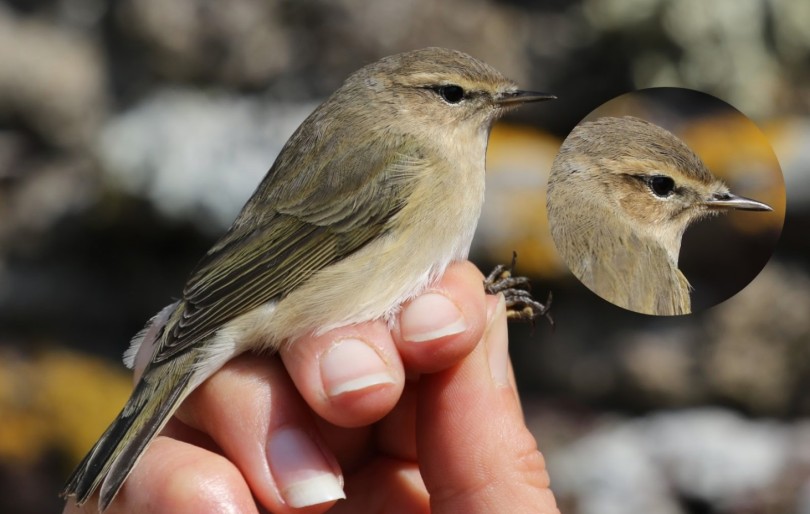Phylloscopus collybita – SIFF-SAFF/SIFF SIAFF – Breeding summer visitor, passage migrant and winter visitor
Photo: Siberian chiffchaff caught on Skokholm © Richard Brown. This was the second spring record of Siberian Chiffchaff for the island. It was interesting to note how the appearance of the ear coverts of today’s bird could change from the classic ‘tobacco’ to rather pale.
The nominate subspecies of chiffchaff P.c. collybita is a summer visitor and according to the 2007-11 BTO atlas, was the most common breeding warbler species in Wales. Two other subspecies breed to the east and north of Britain – P.c. abietinus (Scandinavian chiffchaff)and P.c. tristis (Siberian chiffchaff) and are occasional visitors.
According to the International Ornithological Congress, the tristis subspecies breeds across Russia, as far west as the White Sea, and south to northern Mongolia, and winters across Arabia and east to Burma. Close monitoring by the Welsh Birds Rarities Committee demonstrated that the Siberian Chiffchaff occurs regularly on autumn passage, and there is evidence that southern Britain is becoming an alternative wintering area for some individuals.
Siberian Chiffchaffs are late autumn migrants, most arriving in late October and November but some remain over winter. Most are found along the north and south coasts of Wales, with just a handful recorded inland. A small number of spring migrants have also been recorded, mainly on Bardsey, which are presumed to be wintering individuals moving north.
This article explains how to distinguish between the races.
Pembrokeshire records are as follows:
1995 – Birds ascribed to tristis race noted Monk Haven 11 Mar, Ramsey 25 Sept and St Davids Hd 22 Oct and abietinus race trapped and ringed Pwllcrochan 18 Nov.
1996 – A single bird showing characteristics of the race tristis Skomer 9 Nov.
2003 – In Jan/Feb, up to 6 recorded at Monk Haven, including 1 showing characteristics of the eastern race tristis.
2004 – There were reports of a tristis type bird at Monk Haven in the first winter period. One was showing characters of this race Porth Clais 13 and 18 Nov.
2005 – A tristis type individual was reported Monks Haven in Dec
2014 – Individuals showing characteristics of “Siberian Chiffchaff” P. c. tristis included two at Pembroke Mill Pond on 16th Feb (A. Mears, R. Kelsh) and one was trapped on Skokholm on 2nd Nov, feathers of which were DNA tested by Aberdeen University and confirmed its taxonomy (RB et al).
2015 – Individuals showing characteristics of “Siberian Chiffchaff” P. c. tristis included: at Monk Haven 2nd Jan (DJA et al), on Skokholm 23rd Oct (RDB) and one caught on the Teifi Marshes 15th Oct (CJ, KM).
2016 – Siberian race Phylloscopus collybita tristis: up to two at Milton on 16th Feb – 7th March (RE et al)
2017 – Birds of the Siberian race tristis at Skokholm 28th – 31st May (RB et al – DNA confirmed identification) and two on Skomer on 17th -18th Nov, with one until 19th (ES).
2018 – Three single Siberian Chiffchaffs Phylloscopus collybita tristis on Skokholm on 7th, 16th and 20th Oct (RB, GE). Accepted by WRP on DNA analysis.
2019 – An individual showing characteristics of Siberian Chiffchaff was recorded on Skomer on 27 – 29 Oct.
2020 – Siberian Chiffchaff tristis: one Skokholm 11 April, confirmed by DNA analysis.
2022 – Individuals showing characteristics of Siberian Chiffchaff tristis: Trefin Sewage Works, two 17 Jan and singles 18 Mar & 14 Dec, Hook 6 – 7 Jan, St. Florence 15 Jan, Castlemartin Corse 17 Jan and Rosemarket 30 Jan. Three separate individuals on Skokholm 13, 18 and 28 Apr. Two on Skomer 4 Nov, with a single remaining the next day.
Sources
Records extracted from the Pembrokeshire Bird Reports which may contain more detail than shown here
PRITCHARD R, HUGHES J, SPENCE I M, HAYCOCK B, BRENCHLEY A (Eds) 2020. Birds of Wales. Liverpool University Press

